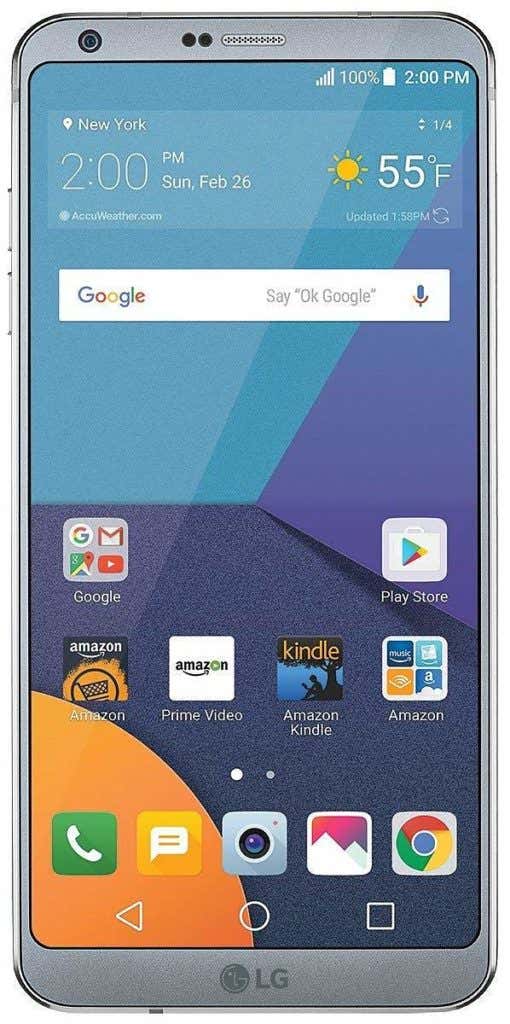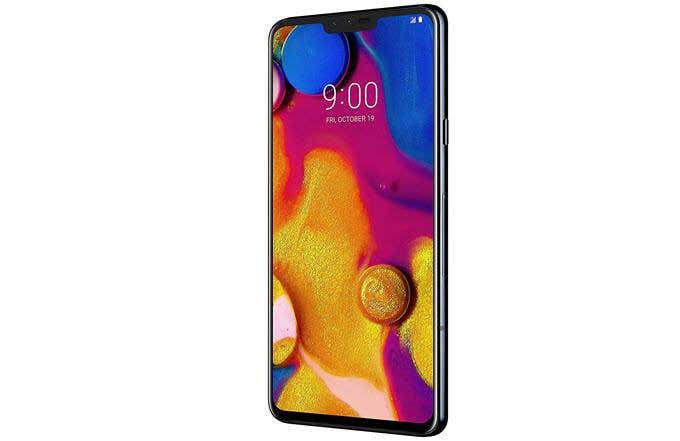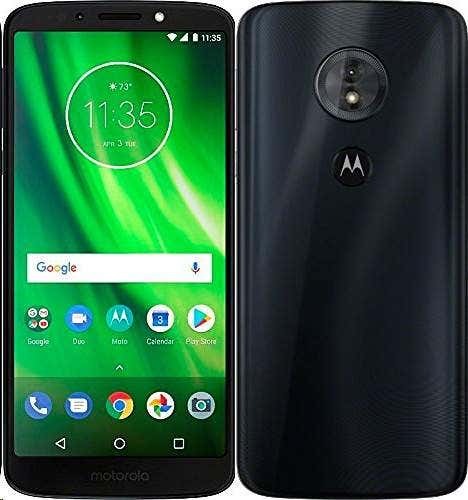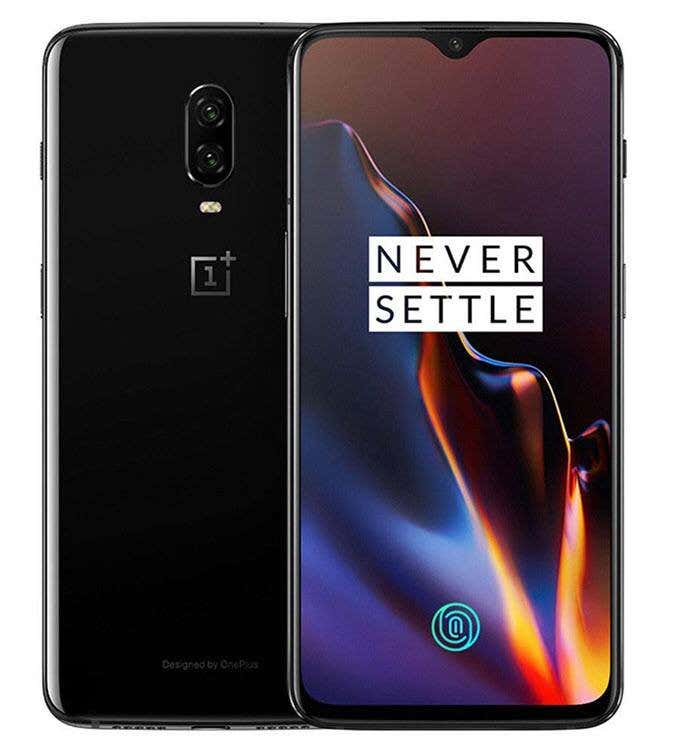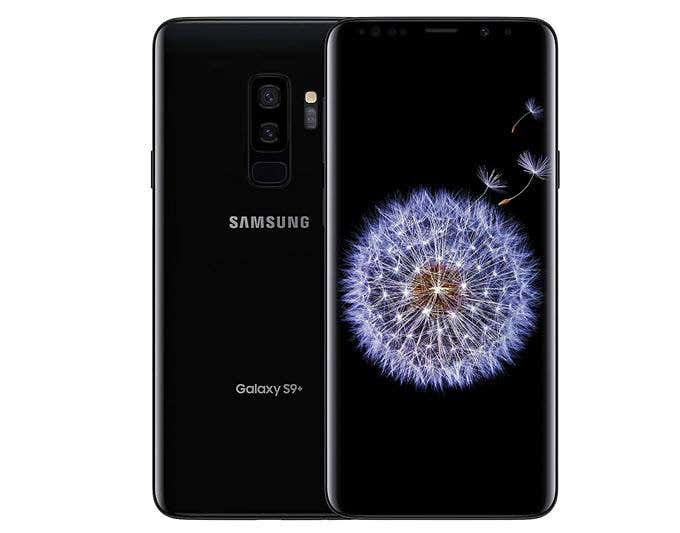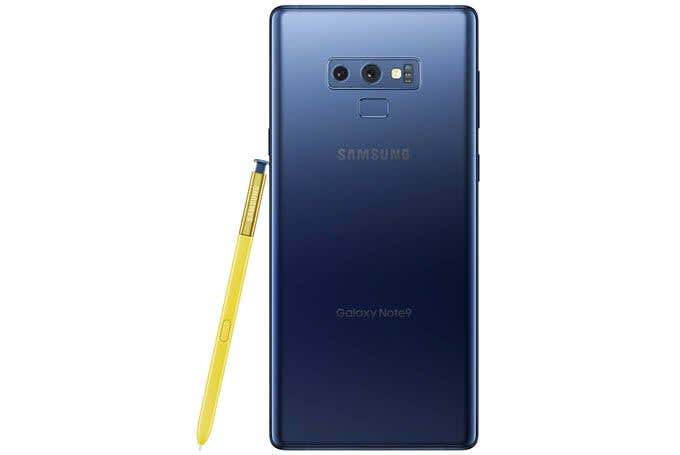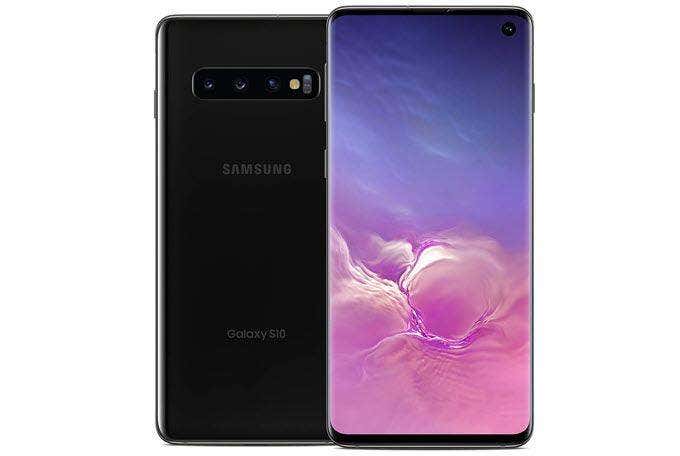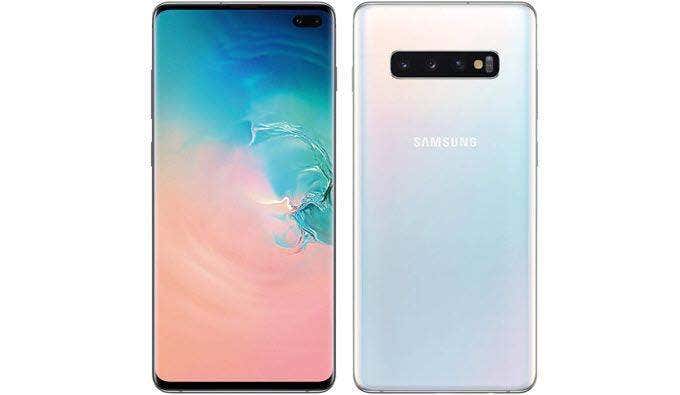As I write this, for example, Samsung is starting to ship the Galaxy S10 and S10+, two of its top (or flagship) phones for release on March 8, 2019, which means that it will become available shortly before this article posts. In addition, prices and operating system updates are in a constant state of flux throughout the year, making zeroing in on how much each phone sells for and what operating system it comes with moving targets, too. I must pick something, right? For the operating system (OS) installed on each device, by now, Android 9 (or Pie) is available for most models, so, the OS listed is the highest version available, again, at the time I write about each specific device. Since the first rollout of the next version of Android won’t happen until August or so, and then only on Google’s Pixel devices initially, those devices that are running Android 9 now will do so for a while. Yes, there will be incremental updates, but for the most part the OS version is consistent—for now.
Why Android?
There are several reasons why Android is the predominant smartphone OS, among them being that unless you’re willing to settle for an older model, all of Apple’s iPhones are high-end and expensive. There are several under-$400 Androids available; I’ve included a couple in this review, and a few in the $500 range. All recent iPhones, as nice as they are, are pushing or exceeding $1,000. More importantly, Android is a more versatile OS with a wider range of features and personalization options. Most Androids, for example, support storage expansions via microSD cards, these days, up to 512GB or more, whereas with iPhones you’re stuck with whatever comes on the phone. If you fill up your storage memory, you’ll have to delete items, or juggle them on and off the device. Yes, you can store more data in the cloud, but that’s not nearly as convenient as having it all right there on your phone. From a techie and developer standpoint, Android is a much more open operating system, meaning that users, app developers and phone manufacturers have a lot more control at the OS level. This allows much more freedom, allowing you, developers, and phone makers to be more creative. Apple’s iOS, on the other hand, is a closed OS. Apple controls virtually everything, which, historically, from the first Mac to the iPhone X, it always has. While this is more conducive to quality control than Google’s approach, it’s also limiting.
Phone Sizes and
Prices
Today’s phones are as powerful as some desktop computers, and the displays on some of the high-end flagships are unbelievably gorgeous. Today’s mobile devices come with huge compliments of storage and RAM, as much as 1TB and 12GB, respectively, and they’re incredibly fast. Many people, especially the younger generations, use only their phones as their sole computing and entertainment devices. If all you need is to make calls and send texts, though, you don’t need all that processing power and to-die-for displays. Nowadays, however, most people do at least some web browsing on their phones, as well as take and share photos. The following list of the 10 best Androids encompass the gambit, from inexpensive and adequate to costly and elegant–some would even say lavish. And this seems like a good spot to inject this disclaimer. The phones in the table below are arranged strangely, due to the fact that I could not fit them all into one table, but had to split it. They aren’t sorted in any particular order. The latest $1,000 Samsung Galaxy S10+, if it’s just what you need, may be best for you, or perhaps the $170 Motorola Moto G6 Play or $360 LG G6 may come with everything you need for the way you use your smartphone. In other words, while I do compare features here, all these phones have made the top 10 list and are therefore strong products for the userbase each one serves. The ultimate best is relevant to application.
Where to Buy Your
Android
At one time, everybody got their phones through their wireless carrier, which locked us into a particular service provider—at least for the term of the contract or until the phone was paid for. The point is, you don’t have to tie yourself to a specific provider anymore. With Android phones, anyway, it’s simply a matter of taking the sim card from your current device and inserting it in the new one. In most cases, as long as the phone is unlocked, it will fire up ready to use your service. Then you can use the device’s switching app to move all your contact, media files, and other data to your new phone. (Samsung, for example, calls this feature Smart Switch.) In any case, now you’re free to shop around, find the mobile device you want at the lowest possible price, with or without financing, and the only real tether between you and your service provider is your monthly bill. If Verizon or whomever doesn’t perform up to snuff, moving to a new carrier is relatively simple.
Google Pixel 3
Basics:
Price: starting at approximately $78012MP rear camera / Dual 8MP selfie camerasApprox. 7.5 hours battery lifeStorage: 64GB/128GBRAM: 4GBScreen size / Resolution: 5.5 inches / 2,160 by 1,080 pixels
Pros: Fast. True, unaltered Android. Fastest OS updates. Easy one-handed operation. Google Assistant voice activation. Gorgeous OLED display. Sharp cameras with above-average AI, low-light, zoom, and other features. Cons: Lacks storage upgrade slot and headphones jack. Google’s flagship smartphone, the Pixel 3 is compact, making it ideal for one-fisted operation. It’s loaded with features and comes in two storage configurations, 64GB and 128GB. If you’re into the big phones with large screens, Google also offers the Pixel 3 XL at slightly higher pricing. Instead of the standard 5.5-inch, 2,160-by-1,080 Pixel 3 screen, the XL model’s display is 6.3 inches and a 2,960 by 1,440 resolution, providing considerably more viewing real estate, but makes for a significantly larger and heavier phone—not to mention a decrease in one-handed functionality, especially for those with smaller mitts. The Pixel 3 comes in four colors, black, white, pink, and not pink, which is a tepid, or pale, pink, and the XL version is available in black, white, and pink. A drawback to the Pixel is that, like Apple phones, it doesn’t support memory expansion through microSD cards (or any other means), nor does it have a headphone jack. It does, however, support Pixel Buds (earphones) via the USB-C charging port on the bottom edge, which means you can’t charge the phone and listen to music at the same time—unless, of course, you charge it wirelessly or use wireless (Bluetooth) earphones. Google’s Active Edge, when you squeeze the sides of the phone, launches Google Assistant. You can’t program Active Edge to launch other apps, though you can also squeeze it to silence alarms, incoming calls, notifications, and timers. Like most phones in this price range, the Pixel 3 is IP68 water and dust proof, and it has one of the most impressive set of cameras in the business, which includes a 12.2MP rear shooter and dual 8MP front-facing selfie cameras.
LG-G6
Basics:
Price: starting at approximately $36013MP rear camera / 5MP selfie cameraApprox. 6.3 hours battery lifeStorage: 32GB – expandable to 2TB with microSD RAM: 4GBScreen size / Resolution: 5.7 inches / 2,880 by 1,440 pixels
Pros:Easy one-handed operation. Great-looking HDR display. Sharp cameras with dual rear. microSD card expansion up to 2TB. Feels durable. Cons: Sluggish. Slightly dull screen. Picks up smudges and fingerprints. Lacks dual speakers. The LG-G6 comes with most of the higher-end flagship features, including IP68 water and dust proofing, as well as a MIL-STD-810G durability rating, meaning that it can withstand from up to 6 feet drops onto hard surfaces, within reason, of course. Like the Pixel 3, the LG-G6’s chassis is glass-coated, and this phone comes only in black, and it shows smudges and fingerprints more prominently than some competing models. Compared to other models, the G6 is a bit oblong with what appears to be a 2.1 display aspect ratio, which could make apps not designed to fit this unusual shape display oddly. Also, unlike several handsets these days, it doesn’t come with dual (stereo) or quad (surround sound), though you do get a headphones jack on the top edge and an SD card slot on the right edge. You can upgrade storage to 2TB, which is the most space I’ve seen supported by any phone, except, of course, other LGs, including the V40 ThinQ.
LG V40 ThinQ
Basics:
Price: starting at approximately $949.99Triple 12MP/12MP/16MP rear cameras / Dual 8MP/5MP selfie camerasApprox. 9.6 hours battery lifeStorage: 64GB – expandable to 2TB with microSD RAM: 6GBScreen size / Resolution: 6.4 inches / 3,120 by 1,440 pixels
Pros:Compact form. Exceptional OLED display. Triple rear cameras take three different angles and dual front cameras shoot wide selfies. MicroSD card supports up to 2TB. Awesome sound and audio software. Cons: Google Assistant button can’t be remapped. Doesn’t support Android 9. Front camera’s low resolution When looking at devices like the LG V40 ThinQ, it’s tough to imagine—even those of us who lived it—a time when all mobile phones did was make and receive calls. The V40 has everything, including three rear cameras that provide a wide range of photo-taking options, such as shooting wide-angle, close-up, and standard shots simultaneously and then stitching them together to create an animated GIF (not to mention excellent traditional shots). You also get a headphone jack with a Hi-Fi quad DAC that, with the right audiophile-quality headphones, delivers perhaps the best sound quality in the business, as well as Bluetooth 5 for listening to more than one audio device at a time. The audio software is also feature-rich, and the speaker located on the bottom edge has a resonance chamber, giving it a “boombox” effect that delivers more and better sound than you’d expect from a phone with only one speaker. As for the dual front cameras, though they are a little low-res, they allow you to shoot wide-angle selfies, making room for friends or for capturing more of the area around you. Like most other phones in this class, the V40 is water and dust proof, and it comes with the MIL-STD-810G standard, meaning that it has been drop-tested from about 6 feet and survived.
Motorola Moto G6 Play
Basics:
Price: starting at approximately $16913MP rear camera / 5MP selfie cameraApprox. 12 hours battery lifeStorage: 32GB–expandable to 256GB with microSD RAM: 3GBScreen size / Resolution: 5.7 inches / 1,440 by 720 pixels
Pros:Cost effective. 12 hours battery life. Strong feature set. Strong performance. Cons: So-so cameras. So-so screen. No wireless charging. No Android 9 yet. There are several budget-minded Androids out there, including several from Motorola, but I found the Moto G6 Play the most impressive. It has the same size battery (4,000mAh) as Samsung’s flagship Galaxy Note 9, resulting in a whopping 12-hour battery life (though the Note 9 lasts over 14 hours), and its cameras, while certainly not the best in the business, shoot highly respectable photos. You get a headphone jack and microSD card support up to 256GB, allowing you to jump storage from 32GB to 288GB—and you get all this for well under $200. Granted, compared to the flagship models in this review, including Motorola’s own V40 ThinQ, the Moto G6’s specs are a little tepid. The 5.7-inch screen’s 1,440 by 720 pixels display is nowhere near as sharp as the ultra-high-resolution OLED and AMOLED screens in higher-end models, and the Moto G6 won’t see an Android 9 update until some time in Q2 2019, which means the year could be half over and Android well on its way to ver. 10, or Android Q, by then. Even so, this is a great phone for the price.
OnePlus 6T
Basics:
Price: starting at approximately $580Dual 16MP/20MP rear cameras / 16MP selfie cameraApprox. 9 hours battery lifeStorage: 128GB/256GB RAM: 6GB/8GBScreen size / Resolution: 6.4 inches / 2,340 by 1,080 pixels
Pros: Reasonably priced. Decent cameras. Fast. Good-looking AMOLED screen. Cons: Lacks storage expansion. Lacks headphone jack. No wireless charging. No waterproofing. While there are a few versions (6GB RAM/128GB storage, 8GB/128GB, and 8GB/256GB) at slightly different prices, OnePlus makes only one phone, currently the 6T. It costs less than many of the flagship models reviewed here, but you give up a lot for the savings, too. What you do get, though, is the same Snapdragon 845 CPU found in today’s leading phones, reasonable but not-the-best performing cameras, a highly attractive, large 6.4-inch (but relatively low-resolution) AMOLED display, decent battery life, and an in-display fingerprint reader for authenticating without turning the phone over. What you give up are wireless charging, water and dust proofing, a headphone jack (though there is a USB-C to 3.5mm dongle in the box, but no headphones), and a microSD card slot. On the other hand, OnePlus phones are quick to receive Android updates with very few alterations to the stock OS, and the 6T is as fast or faster than phones that cost hundreds of dollars more. It’s dual (16MP/20MP) and front 16MP cameras are among the highest resolution in the business, and it comes in either matte or glossy black.
Samsung Galaxy S9+
Basics:
Price: starting at approximately $640Dual 12MP rear cameras /8MP selfie cameraApprox. 10.2 hours battery lifeStorage: 64GB/128GB/256GBRAM: 64GBScreen size / Resolution: 6.2 inches /2,960 by 1,440 pixels
Pros:Reasonably priced. Dual rear cameras with wide-angle and low light capture. Fast. Terrific-looking AMOLED screen. Storage expansion up to 768GB. Strong audio. Cons: Silly AR Emoji. I have included the Samsung Galaxy S9+ in this roundup because, now that the Galaxy S10 and S10+ have been released (yesterday, as I write this), the S9+ has become a terrific value. You get what is essentially the same device, minus a few mostly capacity updates, for less money. Currently, opting for the S9+ will save you $260 over the S10 and $360 over the S10+. Granted, if you need triple cameras, a faster processor, an even higher resolution screen, and so on, then by all means skip this review and move on to the Galaxy S10 and S10+ further down this review. Without question, these are fantastic devices, but if you don’t need and won’t use all the latest bells and whistles, the S9+ is an excellent alternative. It comes with Samsung’s gorgeous Infinity AMOLED 6.2-inch screen, dual rear cameras, Dolby Atmos sound, a 10 hour-plus battery, three different RAM sizes ranging from 64GB to 256GB and expandable via microSD card by up to 512GB. You also get a decent set of headphones in the box, IP68 water- and dust proofing, loud and strong dual stereo speakers—the list goes on… And on…
Samsung Galaxy Note 9
Basics:
Price: starting at approximately $740Dual 12MP rear cameras /8MP selfie cameraApprox. 14.1 hours battery lifeStorage: 128GB/512GBRAM: 6GB/8GBScreen size / Resolution: 6.4 inches /2,960 by 1,440 pixels
Pros:Dual rear cameras with wide-angle and lowlight capture and impressive AI. Long battery life. Fast. Stunning AMOLED screen. Storage with expansion options up to 1TB. Dolby Atmos audio. The Note S Pen with Bluetooth LE. Excellent performance. Cons: Silly AR Emoji. Fingerprint reader too close to the camera. Samsung’s flagship Note 9 (you can see a complete review of the note 9 here) phablet is, next to the iPhone X, one of the most impressive smartphones available. It’s called the Note, of course, because of its S Pen stylus, which with this iteration, now has Bluetooth LE support, which allows you to use the stylus as a remote control for the tablet. By default, the S Pen controls the camera, but it can be remapped to any app that supports the S Pen. This includes Android’s Gallery, Microsoft’s PowerPoint, and several other apps. The Note 9 has similar specs to the S9+, including the dual rear cameras and Super AMOLED display, only this time Samsung has provided software and other updates that make the cameras more accurate and the screen brighter and capable of displaying a wider range of colors. In addition, the Note 9’s screen is slightly larger than the display on the S9+, and the former is available with up to 512GB storage, or twice as much as the slightly smaller S9+. In other words, you can increase storage on the Note 9 up to 1TB. (As you will see in the S10+ review coming up, it is available with a 1TB built-in. More likely than not, the Note 10 coming up later this year, will also have a 1TB option, but like the S10+, it won’t be cheap.)
Samsung Galaxy S10
Basics:
Price: starting at approximately $895Triple 12MP/12MP/16MP rear cameras /10MP selfie cameraApprox. 12 hours battery lifeStorage: 128GB/256GB/512GBRAM: 6GB/8GBScreen size / Resolution: 6.1 inches /3,040 by 1,440 pixels
Pros: Triple rear cameras with wide-angle and lowlight capture and impressive AI. Long battery life. Fastest Snapdragon CPU. Superb Dynamic AMOLED screen. Storage expansion up to 768GB. Impressive Dolby Atmos audio. Also comes in S10e and S10 5G iterations. Cons: Costly. Fingerprint reader next to the cameras. The Galaxy S10 is essentially the S9 on steroids. Everything—the cameras (now triple rear shooters and a 10MP front facing lens), the Dynamic AMOLED display, the RAM, the battery size (now 3,500mAh), and storage size and available sizes—has been upgraded. Also, in addition to the S10+ model reviewed below, Samsung is also offering S10e and S10 5G models. The S10e, a smaller, less-expensive, lesser-endowed model with specs much closer to those of the S9+, and the 5G version, aside from coming with an even larger 6.7-inch screen and a few other enhanced (compared to the S10+) features, supports the next version of cell technology; currently the standard is 4G. The galaxy S10 and its S10+ sibling below is among the most advanced smartphones available so far this year. They are also among the most expensive. As I wrote this, the 512GB model is selling for about $1,150, and as you see coming up the 1TB version of the S10+ costs considerably more than that.
Samsung Galaxy S10+
Basics:
Price: starting at approximately $1,000Triple 12MP/12MP/16MP rear cameras /10MP selfie cameraApprox. 12.5 Hours battery lifeStorage: 128GB/512GB/1TBRAM: 8GB/12GBScreen size / Resolution: 6.4 inches /3,040 by 1,440 pixels
Pros: Triple rear cameras with lowlight and wide-angle capture and remarkable artificial intelligence. 12.5 hours battery life. The fastest Qualcomm Snapdragon CPU. Awesome Dynamic AMOLED screen. Storage expansion up to 1.5TB. Dolby Atmos audio. Cons: Expensive. Fingerprint reader too close to the cameras. Next to the S10 5G, the Galaxy S10+ is, not only the most recent in super-endowed smartphones, but is also the most impressive. The S10+ is everything you can get on the cell phone on steroids. The ultra-high-resolution Dynamic AMOLED 6.4-inch display is nothing short of stunning. The triple rear cameras and Samsung’s camera AI software is incredible, and you have your choice of 8GB or 12GB of RAM and up to 1TB (if you don’t mind spending $1,599.99, that is) of storage, expandable to 1.5TB. Battery life is just shy of 12.5 hours, and there’s not a single feature I can think of, other than an in-screen fingerprint reader, that is not included on this phone. Until release of the Note 10 later this year, and barring something unforeseen and surprising from Apple and Google, we probably won’t be able to find a more advanced mobile device for the next six months or so. Depending on where you are and who you buy from, the S10+ comes in a variety of colors, including: Prism White, Prism Black, Prism Green, Prism Blue, Canary Yellow, Flamingo Pink, Ceramic Black, and Ceramic White.
Sony Xperia XZ3
Basics:
Price: starting at approximately $80019MP rear camera / 13MP selfie cameraApprox. 6.1 Hours battery lifeStorage: 64GBRAM: 4GBScreen size / Resolution: 6 inches /2,880 by 1,440 pixels
Pros: Passable camera. Fast. Stylish design. Cons: Costly. No breakthrough features. Side Sense feature half-baked. Sony’s Xperia XZ3 makes this list primarily because it’s one of the classiest-looking phones available, and because, of course, as a Sony product, it is well-built with no skimping. Like many of the devices here, it runs on the Qualcomm Snapdragon 845 CPU, which, until the recent release of the 855 in the Galaxy S10 models, is one of the fastest smartphone processors available. You also get a 6in 18:9 QHD+ HDR OLED display that, while it’s no match for the Dynamic AMOLED screens on Samsung’s flagship Galaxy models, is, like Sony HDTV’s and computer monitors, gorgeous. The 4GB RAM allocation and 64GB storage capacity is a bit meager, especially for an $800 phone, but you can upgrade it to 576GB with a 512GB microSD card. With the Z3, Sony continues its tradition of great sounding front-facing stereo speakers, as well as a dedicated camera button for launching the camera app. Also included is Sony’s Side Sense feature that, when you double tap the edge of the screen, brings up a menu (or box) of your most used apps and settings. While this is a great idea, it doesn’t always work. In addition, the Z3 lacks facial recognition, which is unfortunate for a phone in this price range.


![]()
